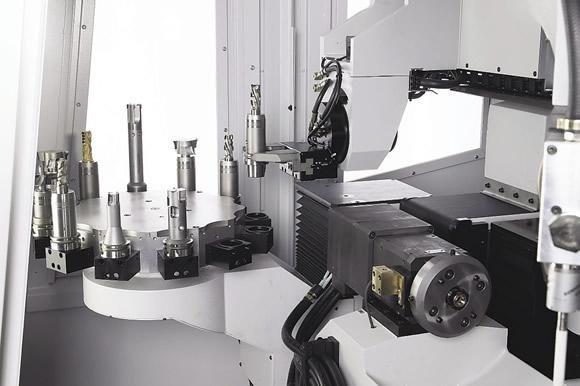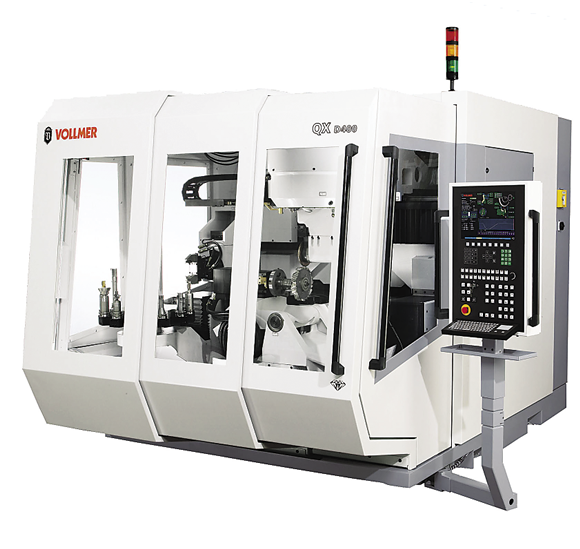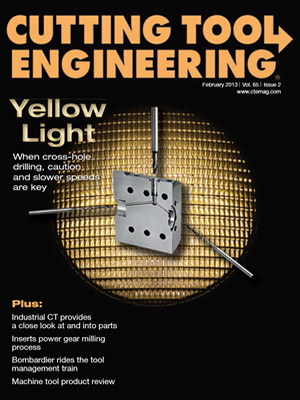END USER: NAP GLADU, (800) 634-8665, www.napgladu.com.
CHALLENGE: Enhance PCD cutting tool design while decreasing processing times.
SOLUTION: A 6-axis rotary erosion machine.
SOLUTION PROVIDER: Vollmer of America Corp., (412) 278-0655, www.vollmer-us.com.
Improving cutting tool design and effectively producing that design are two separate scenarios. NAP GLADU had designed and engineered PCD tools with smaller spaces between the cutting tips than conventional tools to provide more tips on a tool and, therefore, a freer cutting action. One example is an 8 "-dia. cutter with 80 tips.
However, the company wasn’t able to produce the PCD tools efficiently on the rotary erosion machine tools at its facility in Marieville, Quebec, according to Claude Berlinguette, fabrication and service center manager. (The Jasper, Ind.-based toolmaker has 12 North American locations.) “We had to split the tool into two bodies and then assemble it,” he said, noting that it was a way to get around the problem but was not what the toolmaker wanted to do.
After researching its options, NAP GLADU purchased a QXD400 rotary erosion machine from Vollmer of America Corp., Carnegie, Pa. The machine met the toolmaker’s rotary erosion requirements, and NAP GLADU also has a long history of satisfaction with Vollmer’s equipment and service, Berlinguette noted. “It was a big part in our final decision.”
Because the machine was already available at Vollmer’s facility, NAP GLADU was able to set up the machine and receive the required training shortly after purchasing it. The 6-axis QXD400 has one more axis than the toolmaker was used to, which adds capability but requires additional skills from the operator. “Even though we have guys with experience here, it’s a different type of machine with different programs and different setups,” Berlinguette said.
Although the QXD machine series can combine rotary erosion with grinding, Berlinguette noted NAP GLADU only applies rotary copper electrodes to erode its PCD tools. The electrodes range from about 1 " to 8 " in diameter.


The Vollmer QXD400 rotary erosion machine can produce a range of cutting tools.
Berlinguette pointed out that the QXD400 is also able to produce tools with a shear angle up to 45° for enhanced workpiece machinability, which the toolmaker wasn’t able to produce because it didn’t have the proper machine. “We can now provide our high-shear tool to the customer,” he said. “It’s a new design we want to push on the market.”
According to Vollmer, the QXD400 features the machine builder’s latest pulse-generator developments, which decrease processing time by eroding faster while imparting a fine surface finish on a cutting edge. “You can have almost a mirror finish on the diamond tips,” Berlinguette said.
The machine’s six-position toolchanger allows for flexibility in the types of electrodes that can be applied in unattended operation. That benefits NAP GLADU, Berlinguette noted, because the machine can run for up to 36 hours without operator intervention, and the company only runs a single shift on the weekends compared to three shifts throughout the rest of the week. This enables the machine to produce tools from around 11 o’clock on Friday evening until Sunday morning before it needs attending.
The toolmaker uses the QXD400 for making a variety of PCD tools, primarily for cutting wood and aluminum, including saw blades, single- and multiple-piece cutter heads and router bits. “Besides the fact you can produce more tools, besides the fact you impart a better finish and besides the fact you can design and engineer tools differently, you can do any type of tool in this machine,” Berlinguette said.
He added that the QXD400 also enhances productivity because of reduced maintenance downtime. “The main reason you buy a Vollmer is because you have very little maintenance to do on the machine,” he said. “There’s less maintenance with this new machine compared to the other machines we have.”
Related Glossary Terms
- grinding
grinding
Machining operation in which material is removed from the workpiece by a powered abrasive wheel, stone, belt, paste, sheet, compound, slurry, etc. Takes various forms: surface grinding (creates flat and/or squared surfaces); cylindrical grinding (for external cylindrical and tapered shapes, fillets, undercuts, etc.); centerless grinding; chamfering; thread and form grinding; tool and cutter grinding; offhand grinding; lapping and polishing (grinding with extremely fine grits to create ultrasmooth surfaces); honing; and disc grinding.
- machinability
machinability
The relative ease of machining metals and alloys.
- polycrystalline diamond ( PCD)
polycrystalline diamond ( PCD)
Cutting tool material consisting of natural or synthetic diamond crystals bonded together under high pressure at elevated temperatures. PCD is available as a tip brazed to a carbide insert carrier. Used for machining nonferrous alloys and nonmetallic materials at high cutting speeds.
- sawing machine ( saw)
sawing machine ( saw)
Machine designed to use a serrated-tooth blade to cut metal or other material. Comes in a wide variety of styles but takes one of four basic forms: hacksaw (a simple, rugged machine that uses a reciprocating motion to part metal or other material); cold or circular saw (powers a circular blade that cuts structural materials); bandsaw (runs an endless band; the two basic types are cutoff and contour band machines, which cut intricate contours and shapes); and abrasive cutoff saw (similar in appearance to the cold saw, but uses an abrasive disc that rotates at high speeds rather than a blade with serrated teeth).
- toolchanger
toolchanger
Carriage or drum attached to a machining center that holds tools until needed; when a tool is needed, the toolchanger inserts the tool into the machine spindle. See automatic toolchanger.


